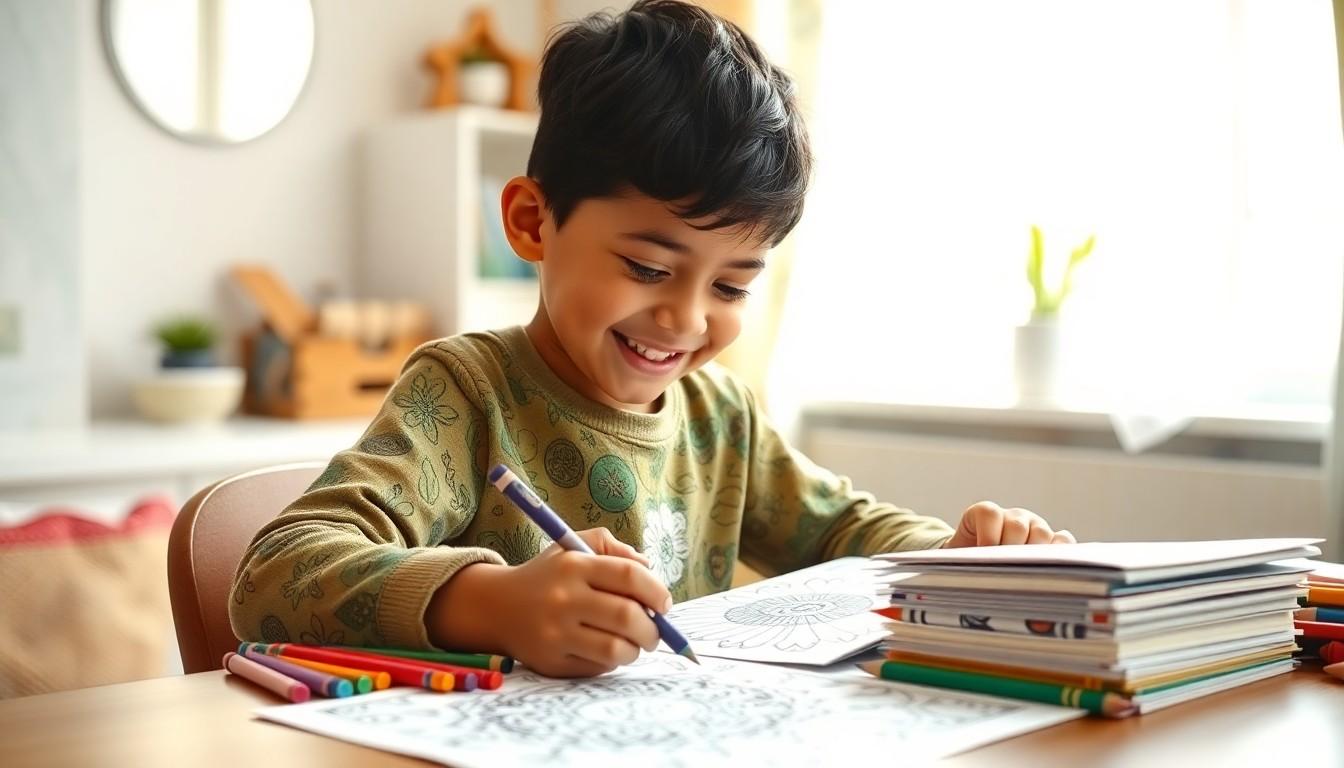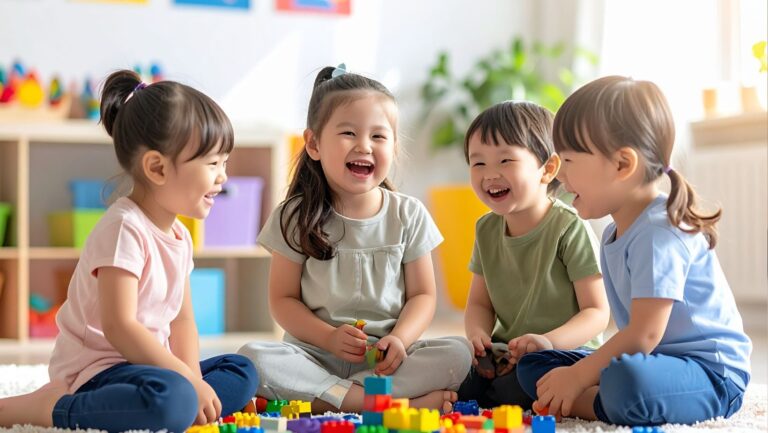Table of Contents
ToggleIn a world where kids juggle school, friends, and the occasional existential crisis about why broccoli exists, mental health coloring pages offer a delightful escape. These pages aren’t just about coloring inside the lines; they’re a fun way for kids to express emotions, reduce anxiety, and unleash their inner Picasso.
Imagine a child immersed in vibrant colors, transforming a blank page into a masterpiece while simultaneously letting go of stress. It’s like therapy, but with crayons! By incorporating these creative tools into their routine, parents can help their little ones navigate life’s ups and downs with a splash of color and a dash of laughter. So grab those colored pencils and watch as kids discover the therapeutic magic of art—because who knew mental health could be so much fun?
Overview of Mental Health Coloring Pages for Kids
Mental health coloring pages for kids serve as valuable resources for emotional expression. These pages often feature calming designs that allow children to focus on creativity while processing their feelings. Engaging in this activity promotes mindfulness, encouraging kids to concentrate on the present moment.
Many parents and educators recognize the therapeutic benefits of coloring. For instance, activities involving colors can reduce anxiety levels in children. Studies show that engaging in artistic expression helps in enhancing mood and reducing stress. While creating art, children may find it easier to articulate their emotions, leading to improved mental well-being.
Coloring pages often include themes that resonate with children, such as nature or animals. Themes designed around positive affirmations also encourage self-esteem and resilience. By selecting pages that reflect a child’s interests, parents can enhance their engagement and motivation.
In addition to emotional benefits, coloring stimulates cognitive development. The use of various colors engages the brain’s problem-solving capabilities and creativity. This dual advantage makes mental health coloring pages an essential tool for any child’s toolkit.
Integrating coloring into daily routines can foster a healthy coping mechanism. Even just 15 minutes of coloring can provide significant relief from overwhelming feelings. Parents may consider setting aside specific times during the week for this activity, allowing children to look forward to it as a special moment for self-care.
Benefits of Coloring for Mental Health
Mental health coloring pages significantly benefit children’s mental well-being through various therapeutic effects. Engaging in this creative activity encourages self-expression, mindfulness, and emotional growth.
Enhancing Creativity
Coloring stimulates creative thinking in children. It allows them to explore colors and patterns while making their own artistic choices. Each stroke of the crayon or pencil fosters imagination and encourages innovative expression. Children can develop problem-solving skills as they decide how to fill spaces and blend colors. By experimenting with different designs, they also gain confidence in their artistic abilities. This creative outlet often leads to increased originality in other areas of life, reflecting a broader spectrum of their creative potential.
Reducing Anxiety
Coloring acts as a calming mechanism that helps reduce anxiety in kids. It provides a focused and meditative experience, allowing children to concentrate on their coloring rather than external stressors. Mindfulness during coloring promotes relaxation, distracting young minds from overwhelming feelings. Studies indicate that even short coloring sessions can lower heart rates and induce feelings of tranquility. Moreover, coloring in serene themes encourages a sense of peace, helping children process their emotions and cultivate resilience in facing challenges.
Types of Mental Health Coloring Pages
Mental health coloring pages come in various styles, catering to different interests and needs. They serve as effective tools for relaxation and emotional expression, each designed to enhance children’s mental well-being.
Simple Designs
Simple designs appeal to younger children and those new to coloring. These pages often feature basic shapes and patterns, making it easier for kids to stay engaged. Clear outlines encourage creativity while minimizing frustration, allowing children to focus on color choice rather than complicated details. These designs can serve a therapeutic purpose by promoting mindfulness, fostering a sense of accomplishment through completed tasks. Bright, bold colors often lead to expressive results, enhancing both mood and self-esteem.
Thematic Pages
Thematic pages encompass a range of topics, providing contextual relevance. Nature themes often include animals, plants, and landscapes, which can evoke feelings of calm and connection with the environment. Pages featuring positive affirmations guide children to affirm their self-worth and resilience through the act of coloring. Other themes, like seasons or holidays, invite kids to explore emotions associated with different times of the year. Themed coloring pages engage children’s imagination while addressing specific emotional needs, promoting a deeper understanding of their feelings. These designed experiences can lead to more meaningful expression and discussion with adults.
How to Use Coloring Pages Effectively
Creating a conducive space maximizes the benefits of coloring pages. Setting up a relaxing environment helps children focus and unwind during art time. Selecting a quiet corner with soft lighting creates an inviting atmosphere. Providing cozy seating, such as cushions or bean bags, encourages comfort. Ensuring access to coloring supplies, like crayons or markers, makes it easier for children to engage with the coloring pages. Decorations featuring calming colors may further enhance the space.
Art offers children a unique way to express emotions. Encouraging expression through art fosters creativity, helping children articulate feelings. Allowing kids to choose their colors promotes personal connection to the activity. Providing prompts or themes may guide their artistic journey. Discussing their choices enhances understanding of their emotions. Using coloring to tell a story provides context for their artwork. Engaging in conversation during the process helps deepen emotional awareness, making art not only enjoyable but also therapeutic.
Tips for Parents and Educators
Integrating coloring into daily routines enhances children’s mental well-being. By setting aside specific times for coloring, kids can look forward to moments of relaxation. Engage children with short sessions, even 15 minutes, to experience significant stress relief. Incorporating themes that resonate with their emotions helps deepen their connection to the activity. Creating a cozy and inviting space facilitates focus and encourages creativity.
Choosing age-appropriate pages ensures children remain engaged and motivated. Simple designs appeal to younger kids, making coloring less intimidating. As children progress, thematic pages about nature or positive affirmations promote deeper emotional understanding. Tailoring selections to individual interests fosters a sense of ownership and excitement during the coloring process. Offering a variety of pages allows kids to explore their creativity and articulate their emotions effectively.
Conclusion
Mental health coloring pages offer children a unique way to express their emotions and manage stress. By incorporating these creative activities into daily routines, parents can help foster emotional growth and resilience. The calming nature of coloring promotes mindfulness and provides a safe space for kids to explore their feelings.
Choosing the right coloring pages tailored to children’s interests can enhance their engagement and enjoyment. Whether it’s simple designs or themed pages, each session can transform anxiety into creativity. Ultimately, integrating coloring into a child’s life not only supports their mental well-being but also nurtures their artistic abilities and self-confidence.





